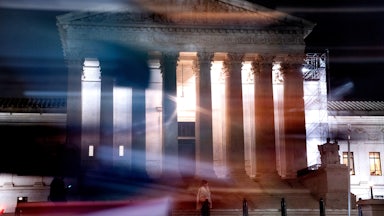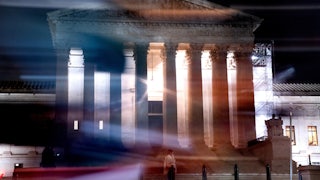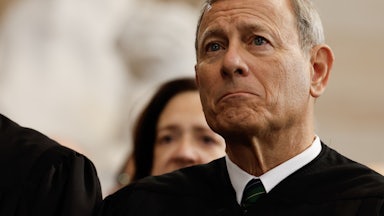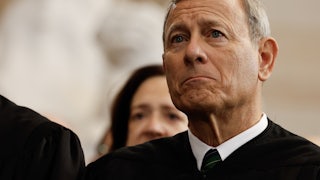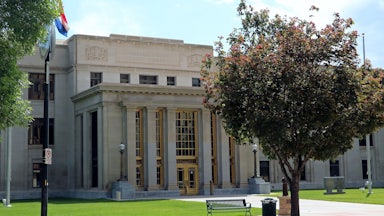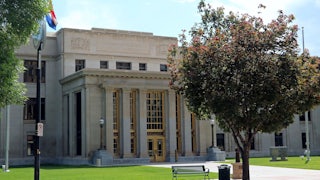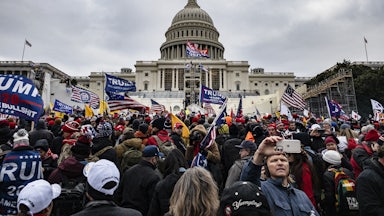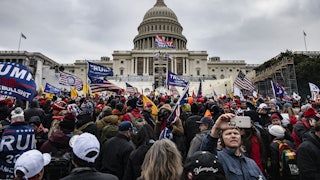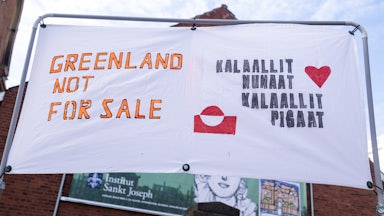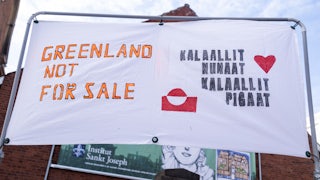Justice Antonin Scalia was not a fan of flag-burning, which he often used as an example of the limits of government power in an open and democratic society. “If it were up to me, I would put in jail every sandal-wearing, scruffy-bearded weirdo who burns the American flag,” he often told audiences at law schools and other public appearances. “But I am not king.”
President Donald Trump disagrees with the latter part. He signed an executive order on Monday that purportedly allows the Justice Department to prosecute people for burning American flags. The White House even helpfully titled the order “Prosecuting Burning of the American Flag.” At a press event in the Oval Office on Monday, Trump touted it as a “very important” order that he hoped would end a purported scourge of flag-burning.
It will probably not accomplish that goal. One big reason is that it appears to have been written by White House lawyers to satisfy a president who wants to do something that is flatly forbidden by the Supreme Court—all while trying to pretend that it is not trying to defy the court’s precedents. The other is that it addresses a phenomenon that barely exists.
“All over the country, they’re burning flags,” the president claimed in the Oval Office. “All over the world, they burn the American flag. And, as you know, through a very sad court—I guess it was a 5-4 decision—they called it freedom of speech. But there’s another much more important reason, which is called death. Because what happens when you burn a flag is people go crazy. If you have hundreds of people, they go crazy.”
“You can do other things, you can burn this piece of paper,” Trump continued, gesturing towards a sheet of paper on his desk, “When you burn the American flag, it incites riots at a level that we’ve never seen before. People go crazy in a way—both ways—there are some that go crazy for doing it, there are others that are angry at them for doing it.”
Prosecuting someone for burning a flag is unconstitutional. By “unconstitutional,” I don’t mean that it could potentially be interpreted as unconstitutional if a court had the opportunity to rule upon the matter. I mean that the Supreme Court has emphatically held for more than 35 years that the First Amendment allows people to burn the American flag without fear of prosecution.
The “very sad” court decision to which Trump referred is the 1989 case Texas v. Johnson. Gregory Lee Johnson, a young communist activist, doused an American flag in kerosene and set it on fire outside the Dallas City Hall to protest the 1984 Republican National Convention. Local police arrested him shortly thereafter for violating a Texas law that prohibited “desecration of a venerated object.” No one was injured.
A Texas jury convicted Johnson, sentenced him to one year in prison, and fined $2,000, which would be equivalent to more than $6,000 if adjusted for inflation in 2025. The Texas Court of Criminal Appeals overturned his conviction on free-speech grounds. “Given the context of an organized demonstration, speeches, slogans, and the distribution of literature,” the court explained, “anyone who observed [Johnson’s] act would have understood the message that appellant intended to convey. The act for which [Johnson] was convicted was clearly ‘speech’ contemplated by the First Amendment.”
At the time, the Supreme Court had never before considered the constitutionality of flag-desecration laws. Forty-seven other states reportedly had similar bans on the books at the time, and a federal statute claimed to prohibit it as well. (Alaska and Wyoming were the two exceptions.) To overcome the First Amendment hurdle, Texas told the Supreme Court that it had two compelling interests in banning flag-burning: “preserving the flag as a symbol of national unity” and “preventing breaches of the peace.”
In a 5-4 decision that included Scalia, the state lost on both counts. Justice William Brennan, writing for the court, found that the “national unity” argument did not outweigh Johnson’s right to free expression. “If there is a bedrock principle underlying the First Amendment, it is that the government may not prohibit the expression of an idea simply because society finds the idea itself offensive or disagreeable,” he explained. Brennan also concluded that the court could not allow a state to prescribe that a symbol has one particular meaning—in this case, patriotism—and criminalize any alternatives.
On the breaching-the-peace argument, things were more complicated. In the landmark 1969 case Brandenburg v. Ohio, the court had already limited the government’s power to punish speech that advocated for violence or illegal activity unless the speech in question called for “imminent lawless action” or is “likely to incite or produce such action.” That high bar means that a state could not punish someone for writing a book about the virtues of rioting, for example, or for arguing in favor of illegal behavior in the abstract.
For this part of Johnson’s case, the court’s analysis was fact-bound. “No reasonable onlooker would have regarded Johnson’s generalized expression of dissatisfaction with the policies of the federal government as a direct personal insult or an invitation to exchange fisticuffs,” Brennan wrote. He affirmed that states retained the power to punish breaches of the peace and noted that Texas already had a separate statute that allowed it to do so.
Only a handful of Supreme Court rulings in the last 40 years caused a greater uproar than Johnson. Broad sections of the American public denounced the court’s decision. Chief Justice William Rehnquist, writing in dissent, compared flag-burning to other “evils” that a civilized society could prohibit like “murder, embezzlement, [and] pollution.” Justice John Paul Stevens claimed that the ruling “diminishes the value of an important national asset.” One survey found that 71 percent of Americans would support a constitutional amendment to overturn the ruling.
Congress responded by passing a new federal law, the Flag Protection Act of 1989, by overwhelming margins. The statute said that anyone who “knowingly mutilates, defaces, physically defiles, burns, maintains on the floor or ground, or tramples upon any flag of the United States” shall be imprisoned for one year. (This was codified as 18 U.S.C. 700(b) in the United States Code.) President George H.W. Bush said that he considered it unconstitutional after the Johnson ruling, but allowed the bill to become law without his signature by declining to veto it.
Trump apparently disagrees and hopes to enforce Section 700(b) against future flag-burners. “And what the penalty will be is that if you burn a flag, you get one year in jail,” Trump interjected. “No early exits, no nothing. You get one year in jail. If you burn a flag, you get—and what it does is—incite to riot. I hope they used that language, by the way. Incite to riot. And you burn a flag, you get one year in jail. You don’t get ten years, you don’t get one month, and it goes on your record.”
The problem is that the Supreme Court already said no. Almost immediately after the law’s passage, Johnson and two fellow protesters burned a flag in a public protest and were prosecuted accordingly. The Supreme Court, along the exact same 5-4 lines as last time, struck down the Flag Protection Act in the 1990 case United States v. Eichman. The justices were not persuaded by the Justice Department’s claims that it was merely protecting the “physical integrity” of the flag instead of punishing free expression. Though lawmakers occasionally floated a constitutional amendment in the years that followed, it never gained traction.
Trump’s executive order tries to get around Johnson and Eichman by leaning on the breaching-the-peace interest. “Notwithstanding the Supreme Court’s rulings on First Amendment protections, the court has never held that American flag desecration conducted in a manner that is likely to incite imminent lawless action or that is an action amounting to ‘fighting words’ is constitutionally protected,” the order’s preface claimed, citing Johnson.
This does not really make sense. Someone can burn a flag while inciting imminent lawless action. They could hold a burning flag aloft while telling their fellow rioters to smash a car. I suppose a group of people could agree in advance to use a burning American flag as a signal to coordinate their illegal actions, though that seems inefficient and unrealistic (and also outside Johnson’s scope since it would not be expressive conduct). But the act of burning a flag cannot itself amount to a direct call for imminent lawless action under Johnson.
Other parts of the order are similarly befuddled. The order’s substantive language, for example, is filled with caveats. “The Attorney General shall prioritize the enforcement to the fullest extent possible of our nation’s criminal and civil laws against acts of American flag desecration that violate applicable, content-neutral laws, while causing harm unrelated to expression, consistent with the First Amendment,” it declared.
This may sound bold and authoritative to a layperson but it is nonsensical to anyone who’s read Johnson and Eichman. Unless someone is using a burning American flag in furtherance of another illegal act—maybe by using it to set people or other property aflame?—it is hard to imagine a context where burning an American flag in and of itself is not expressive conduct protected by the First Amendment. Trump’s order, as written, is akin to telling someone to ignore red lights and stop signs to the fullest extent permitted by local traffic laws.
One possibility is that Trump is trying to get the Supreme Court to overturn Johnson and Eichman. The order even encourages the attorney general to “pursue litigation to clarify the scope of the First Amendment exceptions in this area.” Nobody can really blame him for thinking of the court as a Pez dispenser for favorable rulings after the last 18 months. At the same time, none of the justices have publicly signaled any interest in doing this.
The closest that any have come was when Justice Clarence Thomas, who joined the court one year after Eichman was decided, favorably cited Rehnquist’s Johnson dissent while dissenting alone from a 2003 case on Virginia’s anti-cross-burning law. He argued against the court’s decision to significantly narrow the statute. Even then, that case was an outlier in Thomas’s general approach to free-speech cases. It is not hard to guess why he might take umbrage to eight Northerners and Westerners downplaying the uniquely violent implications of burning crosses.
Of all the criticism that can be leveled at the Roberts Court in general, scaling back major First Amendment precedents is not among them. The court’s conservative majority has left the 20th century’s landmark free-speech rulings intact and applied them evenhandedly in some of the most emotive cases possible. A court that can recognize First Amendment protections for funeral protests for dead soldiers and commercialized animal-abuse footage can probably stomach a burning American flag.
There is one important catch here. Trump also directed the relevant agencies to “deny, prohibit, terminate, or revoke visas, residence permits, naturalization proceedings, and other immigration benefits, or seek removal from the United States” if there was any evidence that the non-citizens in question participated in flag-burnings. While the First Amendment theoretically applies to non-citizens, the Supreme Court’s recent approach to executive power and deportations does not give them much reassurance.
It is hard to imagine that the number of non-citizens who burn flags is that large because the number of people who burn American flags is not large, either. The phenomenon largely exists on Fox News B-roll footage of old protests. Perhaps that is why Trump is so confident that his order will end it. “You will see flag-burning stopping immediately,” he continued on Monday. “Just like when I signed the Statue and Monument Act. Ten years in jail if you hurt one of our beautiful monuments. Everybody left town. They were gone. Never had a problem after that. It was pretty amazing. We stopped it.”
There is no “Statue and Monument Act,” just as there are no riots that began because someone burned an American flag. Trump signed an executive order five years ago on the matter to prioritize prosecutions after the George Floyd protests, but there is no evidence that it led to a higher number of cases than would otherwise exist—and an executive order is definitely not an act of Congress. He thinks it worked because he stopped seeing it on TV. Flag-burning offends many Americans who see it as an attack on their national values. The same could be said for a president who issues unconstitutional orders to attack free speech on fictitious grounds.

